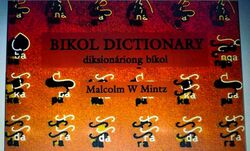Social:Basahan
| Basahan Guhit, Súrat Bikolnon | |
|---|---|
 | |
| Type | Abugida
|
| Languages | Bicol |
Parent systems | Proto-Sinaitic alphabet
|
Sister systems | In the Philippines:
Buhid Balinese Batak Javanese Lontara Sundanese Rencong Rejang |
Basahan script, also known as Guhit, is the native name used by Bicolanos to refer to Baybayin.
The word Basahan is already recorded in a book entitled Vocabulario de la Lengua Bicol by Marcos de Lisboa in 1628 which states that it has three vowels and fifteen consonants.[1]
Alphabet
Basahan has three stand-alone vowels (a, e/i, o/u) and fifteen consonants (ba, ka, da, ga, ha, la, ma, na, nga, pa, ra, sa, ta, wa, ya). This script can be called an abugida because signs represent syllables, that is a consonant with a vowel.
Way of writing
According to Scott, when e.g. the sign for ba has to be read as be / bi it has a kaldit (a small "v" shaped diacritic sign) on the left (or above), if it has to be read as bu / bo the kaldit is on the right (resp. below). The basahan of the older bikolanos has an own sign for /r/ while the basahans of Tagalog (Baybayin) and Ilokano (Kurdita) have not.[2] In his time the kaldit was called kaholoan or holo according to Marcos de Lisboa, author of the earliest dictionary of Bikol.[3][2]
References
- ↑ Lisboa, Maŕcos de (1865). "Vocabulario de la Lengua Bicol". Vocabulario de la Lengua Bicol. p. 60. "BASAHAN. pc. El a, b, c, de ellos por donde aprenden á leer que tiene quince letras consonantes, y tres vocales, a, e, o.".
- ↑ 2.0 2.1 Scott, William Henry (2004) (in en). Barangay. Ateneo de Manila University Press. p. 186. ISBN 971-550-135-4.
- ↑ Lisboa, Maŕcos de (1865). "Vocabulario de la Lengua Bicol". Vocabulario de la Lengua Bicol. p. 86. "CAHOLOAN. pc. Una virgula de esta manera, V. que ponen á los lados de sus caractéres, etc.".
External links
 |




